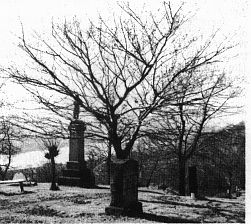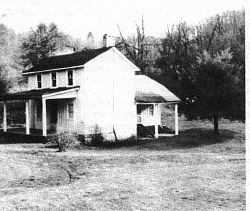
The dark thin slab on the right is grave marker for John McKee, 1740-1834.
Click Here to Return To Milestones Vol 9 No 1
The crow's found a natural sanctuary as they nested and rested in the tall hemlocks that once interspersed the valley', an early settler, John McKee, translated the Indian name into English -Crow's Run.
It was there that McKee lived and later died at the age of ninety-four. He was buried on a bluff overlooking a portion of the valley. The epitaph on his tombstone bears testimony to the contribution of his patriotic deeds: "In memory of John McKee who departed from this life December 14, 1834, aged 94 years. Emigrated to this adopted country in the year A.D. 1765, was at the destroying of the tea in Boston, present at the Declaration of Independence, served two years in the Revolutionary War and took his share in the glorious struggle of gaining our independence." In smaller letters: J.W. Thompson, Stonecutter. Because of the desecration of other tombstones in the McKee burial site, the headstone was removed to the Soldier's Monument in Oak Grove Cemetery in Freedom in 1942 by the Daughters of the American Revolution.
McKee's service in the war merited him a land grant of 800 acres in the Crow's Run Valley; grants such as these were "depreciation lands" given by the State of Pennsylvania as payment to the soldiers and officers for their meritorious services in the war. McKee's land extended from the Ohio River into the valley enhanced by a sizable stream, wild-life, and other natural resources.
Upon his arrival to his new home-site McKee built a log cabin and established a good rapport with the Indians. (His neighbor, John Wolf, who lived to the east of McKee wasn't as fortunate; in order to fend off the wiles of the Indians it was necessary for him to erect a blockhouse). At the turn of the century, McKee set aside some land on the bluff behind his cabin for the burial site. It also became the resting place for some Revolutionary soldiers.

During his life-time, McKee proved himself as an enterprising business person. In 1796 he traded some of his land for an area now known as Fallston, then three years later sold his interests to a David Townsend. In 1825, McKee sold land situated at the lower end of Crow's Run to a Michael Conway, the founder of the town of Conway. The Conway family is buried in a private burial plot on a hill-side not too far from the busy Rt. 65 Highway. The monies derived from the sale of the land was used by McKee to promote the first railroad in the area -later it became known as the Pennsylvania Railroad and today it is widely known as the ConRail.
Alexander McKee, unlike his brother, carried a captain's commision from the British. After leaving the McKee's Rock's area he also built a log cabin in Crow's Run. Soon he bevame involved with the Girty brothers. The brothers led the Indians raids upon the white settlements. Simon, the most infamous of the four, was declared a traitor by the Pennsylvania legislature, and for his terroristic forays was called "the great renegade".
With the arrival of more settlers the valley began to show signs of an industrial awakening. The natural resources afforded the new-comers profitable livelihoods: there was stone to be quarried, trees to be hewn and sawn. coal and clay to be mined, bricks to be manufactured -and oil to be drilled.
John Dean came from Ireland in 1830, established a saw-mill and opened the first store in the area. Mr. Dean made monthly trips to Old Allegheny for his store supplies; his mode of transportation: a Conestoga wagon driven by a team of oxen. In 1833, Eliza Dean taught school to youngsters in a one room classroom. The Deans accomplished much during their brief stay, then in 1838 they moved to Allegheny, where John Dean died there in 1884.
Another early settler, Edward Garrett, came from Ireland. He was a stone mason and a bricklayer in addition to quarrying stone and coal mining. The Garrett family name is well-known in the Beaver Valley.
James Park came to Crow's Run in 1845 and for many years operated a general store. His two sons, William A. and John H., were active in the promotion of the valley's rapid growth which began in the 1880's. The organization of Park Fire Clay company was added to their other interests, the merchantile and quarry businesses.
An ample source of an excellent quality clay provided the needs for the two brickyards located on. the west side of the valley. Each yard had a separate shaft that tunneled into the hill for the clay. The yards were referred to as No. 1 Works and No. 2 Works. The bricks that were manufactured were hard and durable and at that time were used extensively for paving purposes throughout the Beaver Valley. Many more were shipped to various parts of the United States and Canada. The 350 men employed by the company were capable of making 250,000 bricks daily; some of the employees and their families were housed in frame look-alike dwellings more commonly called "company houses".
In order to facilitate the transportation aspect of the industries, John Park built the North Shore Railroad from the Park Quarries to the Pennsylvania Railroad.
The saga of the Crow's Run era was highlighted by the oil boom that emerged on the scene in the early 1900's. The first well drilled was on the Robert Wallace farm. Others followed in quick succession. A number of wells were drilled on the Whipple, Stewart, Kramer and McElhaney farms. There were no less than ninety oil wells and several gas wells that were productive during that period.
The activity that took place in the region of the now Rt. 989 and the Freedom-Freeport Rd. was dubbed "Wallace City". The Park brothers extended the North Shore Railroad three more miles to Wallace City to accommodate the new-found industry. To do so it was necessary to blast through a quarter-or-a-mile of solid rock before two tunnels were made; today the isolated tunnels remain as sentinels in affirmation of the tenacious endeavors by past laborers. The Park brothers had hoped to extend the railroad to Callery, but these plans were cancelled when it became apparent that the oil wells were no longer productive. The derricks, blacksmith shops, boarding houses and other service buildings in Wallace City were dismantled and by the early Twenties there was no trace left of the once bustling oil business.
In 1919, the Park Company stopped firing brick at its No. 1 yard. However, a large inventory of bricks were lost on June 28, 1924 due to a severe cloud-burst that devastated parts of Beaver County. The swift waters of the rampaging Crow's Run Creek caused many stacks of bricks to collapse into the stream. (For years the scattered bricks lay embedded in the creek, on its banks and elsewhere.) Sections of the railroad tracks were uprooted and twisted, sometimes suspended without support where erosion had occurred. All of this destruction was costly to the owners. Also the demand for paving brick lessened when the more efficient cement medium was preferred for paving. So it was that in the late twenties the second brickyard was closed. The dismantlement of the No. 2 Works brought to an end the industrial hey-day of the Crow's Run Valley.
In addition to the industrial climate of the valley. there was a one room schoolhouse, a Post Office at the Park Quarries and two churches. The House of Mercy Lutheran Church, which was built in 1879, still holds Sunday services. The small edifice sits in a scenic glen and continues to remain a symbol of the spiritual aspect in the making of history in the Crow's Run Valley.

Editor's note: Mrs. Stryker was born in 1919 in the vicinity of the No. 2 works. She can remember, vividly, the cloud burst of 1924 and the damage it caused to the No. 1 Works.